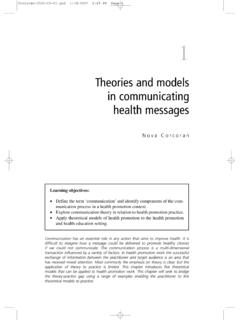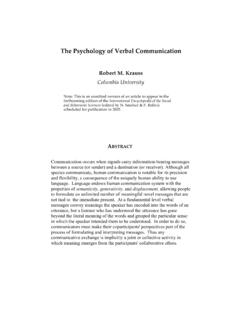Transcription of Social Cognitive Theory of Mass Communication
1 Requests for reprints should be sent to Albert Bandura, Department of Psychology,Jordan Hall, Building 420, Stanford University, Stanford, CA94305 2130. Cognitive Theory of Mass CommunicationAlbert BanduraDepartment of PsychologyStanford UniversitySocial Cognitive Theory provides an agentic conceptual framework withinwhich to analyze the determinants and psychosocial mechanisms throughwhich symbolic Communication influences human thought, affect and systems operate through two pathways. In the dire c tpathway, they promote changes by informing, enabling, motivating, andguiding participants.
2 In the socially mediated pathway, media influences linkparticipants to Social networks and community settings that provide naturalincentives and continued personalized guidance, for desired change. Socialcognitive Theory analyzes Social diffusion of new styles of behavior in terms ofthe psychosocial factors governing their acquisition and adoption and thesocial networks through which they spread and are supported. Structuralinterconnectedness provides potential diffusion paths; sociocognitive factorslargely determine what diffuses through those of the influential role the mass media play in society, understanding thepsychosocial mechanisms through which symbolic Communication influenceshuman thought, affect, and action is of considerable import.
3 Social cognitivetheory provides an agentic conceptual framework within which to examine thedeterminants and mechanisms of such effects. Human behavior has often beenexplained in terms of unidirectional causation, in which behavior is shaped andcontrolled either by environmental influences or by internal dispositions. Socialcognitive Theory explains psychosocial functioning in terms of triadic reciprocalMEDIAPSYCHOLOGY,3,265 2001, Lawrence Erlbaum Associates, 6 6 BANDURA causation (Bandura, 1986).
4 In this transactional view of self and society, personalfactors in the form of Cognitive , affective, and biological events, behavioralpatterns, and environmental events all operate as interacting determinants thatinfluence each other bidirectionally (Fig. 1). Social Cognitive Theory is founded in an agentic perspective (Bandura, 1986,2001b). People are self-organizing, proactive, self-reflecting, and self-regulating,not just reactive organisms shaped and shepherded by environmental events orinner forces. Human self-development, adaptation, and change are embedded insocial systems.
5 Therefore, personal agency operates within a broad network ofsociostructural influences. In these agentic transactions, people are producers aswell as products of Social systems. Personal agency and Social structure operateas codeterminants in an integrated causal structure rather than as a from the sociocognitive perspective, human nature is a vast potentialitythat can be fashioned by direct and observational experience into a variety offorms within biological limits. To say that a major distinguishing mark of humansis their endowed plasticity is not to say that they have no nature or that they comestructureless (Midgley, 1978).
6 The plasticity, which is intrinsic to the nature ofhumans, depends upon neurophysiological mechanisms and structures that haveevolved over time. These advanced neural systems specialized for processing,retaining, and using coded information provide the capacity for the verycapabilities that are distinctly human: generative symbolization, forethought,evaluative self-regulation, reflective self-consciousness, and symboliccommunication. These capabilities are addressed in the sections that of triadic reciprocal causation in the causal model ofsocial Cognitive CAPABILITYS ocial Cognitive Theory accords a central role to Cognitive , vicarious, self-r e g u l a t o r y, and self-reflective processes.
7 An extraordinary capacity forsymbolization provides humans with a powerful tool for comprehending theirenvironment and creating and regulating environmental events that touchvirtually every aspect of their lives. Most external influences affect behaviorthrough Cognitive processes rather than directly. Cognitive factors partlydetermine which environmental events will be observed, what meaning will beconferred on them, whether they leave any lasting effects, what emotional impactand motivating power they will have, and how the information they convey willbe organized for future use.
8 It is with symbols that people process and transformtransient experiences into Cognitive models that serve as guides for judgment andaction. Through symbols, people give meaning, form, and continuity to gain understanding of causal relationships and expand theirknowledge by operating symbolically on the wealth of information derived frompersonal and vicarious experiences. They generate solutions to problems,evaluate their likely outcomes, and pick suitable options without having to gothrough a laborious behavioral search.
9 Through the medium of symbols peoplecan communicate with others at any distance in time and space. However, inkeeping with the interactional perspective, Social Cognitive Theory devotes muchattention to the Social origins of thought and the mechanisms through whichsocial factors exert their influence on Cognitive functioning. The other distinctivehuman capabilities are founded on this advanced capacity for are not only knowers and performers. They are also self-reactors with acapacity for self-direction.
10 Effective functioning requires the substitution of self-regulation for external sanctions and demands. The self-regulation of motivation,affect, and action operates partly through internal standards and evaluativereactions to one s own behavior (Bandura, 1991a). The anticipated self-satisfaction gained from fulfilling valued standards and discontent withsubstandard performances serve as incentive motivators for action. T h emotivational effects do not stem from the standards themselves, but from theevaluative self-investment in activities and positive and negative reactions toone s O C I A LCOGNITIVE T H E O RYOF MASS COMMUNICAT I O N2 6 72 6 8 BANDURAMost theories of self-regulation are founded on a negative feedback system inwhich people strive to reduce disparities between their perceived performanceand an adopted standard.






